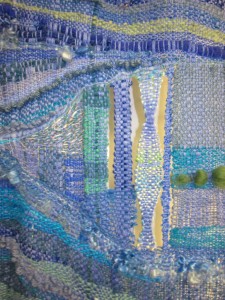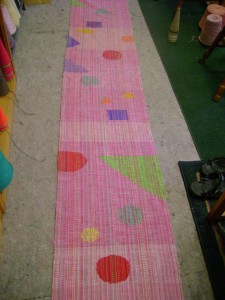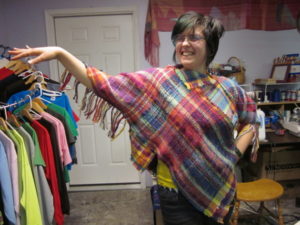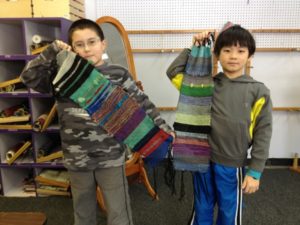SAORI Weaving
is an art of weaving by hand that is dedicated to free expression and self-development for everyone, regardless of physical or mental ability, age, or artistic aptitude. SAORI Weaving is pure improvisation from the heart, with no premeditated pattern in mind. Colors unfold, designs emerge, and beauty blooms directly from the genius of each unique individual working in harmony with loom, thread, and the spark of the moment. SAORI Weaving is a profound inner journey, yet we can enjoy it socially, working alongside others. We can also create clothing, bags, tapestries, and many useful items that can be appreciated by all. SAORI Weaving is fun, and anyone can do it!
Meaning of SAORI Weaving
Actually, “SAORI” is a trademark of Sakaiseikisangyou Co. in Osaka, Japan for the method and the teaching. This is the company that manufactures the SAORI loom and operates a weaving studio. Originally when the founder Misao Jo was asked to name her work for its originality, she created the word “SAORI” which comes from “Misao’s ori”. (“ori” means “weaving” in Japanese.) Later, SAORI weavers realized the “sa” could mean “differences”. It could mean “weaving defferences between machines and human beings” or ‘weaving differences between each other”. So, because of these spiritual roots, as experienced and expressed by founder Misao Jo, SAORI is more than just a technique. It is also:
- A philosophy that all people are artists: each of us has a latent intuitive power that SAORI can awaken
- An aesthetic that embraces the natural beauty of unintended “mistakes” and encourages exploring the unknown.
- A social movement towards bringing diverse people together to learn from one another. It is especially a movement to include within a larger community people who may be isolated or marginalized because of disability, age, income, occupation, ethnicity, or other reasons.
- An artistic yet practical path of meditation, therapy, rehabilitation, trauma recovery, stress reduction, identity-building, community-building, economic self-reliance, and holistic human development.
 History of SAORI Weaving
History of SAORI Weaving
In Japan in the late 1960s, Misao Jo, then in her mid 50s, decided she wanted to weave a sash (obi) for her kimono by hand. Her husband and sons built her a handloom, and her 84-year-old mother taught her how to weave!
However, Ms. Jo soon felt that her weaving in the conventional style was imitating the regularity and predictability of a machine. She said, “I have a brain and emotion. I’m a human being. I will weave an obi that is full of humanity.” She allowed herself to skip threads in an unforced, rhythmic way, introducing unusual stripes and fringes that resulted in original work of striking expressiveness. She kept experimenting, enjoying herself to a degree that she hadn’t believed possible, but wondering whether others would perceive her work as “really good.”
Finally, she brought her work to the owner of a fashionable kimono shop. To her surprise and delight, he bought all the work she showed him, sold it quickly, and asked for more. When she tried to fill his orders for a specific pattern she had made previously, however, she found that her joy in weaving was gone. Realizing that spontaneity was the secret of her success, she determined to teach this wonderful way to others. Today, at age 99, she is still weaving SAORI.
 You will find out more details of the founder’s thoughts in the book “SAORI Self-Innovation Through Free Weaving”. This book is available at our Etsy Shop.
You will find out more details of the founder’s thoughts in the book “SAORI Self-Innovation Through Free Weaving”. This book is available at our Etsy Shop.


